MADO ransomware encrypts personal files, leaving no way to recover them for free
Contents
MADO ransomware is a dangerous malicious file-encrypting crypto-virus that is from STOP/DJVU malware family. The virus is designed to make personal files inaccessible to the victim by encrypting them, mark them with .mado file extensions, then leave a ransom-demanding message in _readme.txt ransom note. On top of that, the virus modifies Windows hosts file and blocks access to popular computer-related websites. Finally, the virus installs password-stealing AZOrult malware. To decrypt corrupted data, ransomware developers demand paying $490-$980 in Bitcoin.
The virus acts silently and during its operation it displays a fake Windows update window for the user. Meanwhile, data encryption procedure takes place. To encrypt victim’s files, MADO ransomware virus connects to its Command&Control server to get an individual encryption key and saves the matching decryption key on the server.

Once the key is obtained, the ransomware can begin the encryption procedure, during which each individual file gets corrupted using specific encryption key and marked with .mado file type extension. Next, the virus modifies Windows Hosts file, blocking access to sites like microsoft.com and similar.
By the end of the cyber attack, the ransomware has all personal videos, images, documents and other file types encrypted. Each affected file folder now has _readme.txt ransom note saved on it, so that the victim could open and read the message from the attackers instantly.
_readme.txt urges to pay ransom: is there hope to decrypt data in other way?
If you’re wondering whether the information in _readme.txt note is full of lies or not, continue reading further.
The message explains that all files were encrypted with military-grade encryption, and free recovery is simply not an option in practice. At his point, the ransomware developers are right – even with the most powerful computers it would take years to break the encryption just for one key. Therefore, the attackers suggest paying up the price specified in the note – $490 within 3 days, or double the price ($980) later. The victim is commanded to write to helpdatarestore@firemail.cc or helpmanager@mail.ch to get further details on decryption and payment.
It is true that there is no way to recover encrypted files for free, unless you have a data backup. However, we do not encourage you to pay a ransom. Instead, remove MADO ransomware virus as soon as you can. We recommend using PC Repair software for virus damage repair – for example, RESTORO. Automatic malware removal tool can detect and delete all related malware, such as AZORULT in this case.

Typically, many computer users just happen not to have data backup in case of a ransomware attack. Such statistics aren’t uplifting, considering the number of malware attacks nowadays. However, if you didn’t have data backup, there is one slight chance you might have to decrypt your files. You need to use instructions in STOP/DJVU decryption guide and figure out if your data is subject to offline or online encryption.
Threat Summary
| Name | MADO ransomware |
| Type | Ransomware |
| Version | 217th version of STOP/DJVU |
| Ransom note | _readme.txt |
| Ransom price | $490 or $980 |
| Extension | .mado file extension |
| Symptoms | Ransomware encrypts files and adds new extensions after original ones; leaves _readme.txt notes which demand ransom in exchange for data decryption tools. The victim can no longer open files regardless of software used |
| Contact emails | helpdatarestore@firemail.cc (primary email), helpmanager@mail.ch (secondary) |
| Associated processes | 1A3E.TMP.EXE |
| Distribution | Spreads via illegal file sharing platforms, typically hides in software cracks, movies, or other illegally distributed copyrighted content |
| Removal | Remove virus damage using software like RESTORO. |
| Decryption | Decryption is now available for victims affected by the offline encryption. See more in this STOP DECRYPTER GUIDE. |
Modification of the HOSTS file
MADO file virus is a new DJVU variant (there are two categories – old and new ones), which means that you’ve been infected with a variant that has even more capabilities than its old versions. One of its new features is ability to modify HOSTS file, add domain names and IPs to block.

The virus adds a whole list of computer or cybersecurity-related websites to it, preventing the victim from accessing self-help and malware removal guides online. Clearly, the malware developers seek to frustrate the victim as much as possible and force him to pay the ransom immediately. Sadly, paying the ransom won’t solve the matter at all.
Searching for software cracks? You might end up with ransomware on computer
MADO ransomware spreads via illegal online downloads. Just like JOPE, OPQZ, REMK or FOOP viruses, you can download it along a software keygen, crack or other illegal install-paid-software-for-free tools. Stay away from such shady and untrustworthy downloads as far as you can. Instead of downloading such dangerous content, we encourage you to support software developers and purchase legitimate program versions only.
Victims of the discussed ransomware have already reported installing the virus along KMSPico, game cracks, Photoshop cracks and similar files.
The discussed virus is very similar to other ransomware threats such as NEMTY, PHOBOS or DHARMA. To avoid ransomware in general, we recommend you to get real-time malware protection software, create data backups regularly on external data drives, and avoid clicking on suspicious links or attachments online.
Easy way to remove MADO ransomware
You should remove MADO ransomware virus along with related malware using the guide provided below. We also recommend a PC Repair software for fixing virus damage on your computer caused by the said ransomware. For example, it affected essential HOSTS file and others to implement as much damage as possible. You can revert such damage using RESTORO.
After completing MADO virus removal, do not forget to check passwords stored in your browsers. Then change them for each website you used them on. As mentioned earlier, the ransomware installs a password-stealer on the system, so after removing them both you need to make sure hackers won’t try to infringe your privacy again.
OUR GEEKS RECOMMEND
Our team recommends removing malware using a professional antivirus software.
REMOVE THREATS WITH ROBUST ANTIVIRUS

Get INTEGO ANTIVIRUS for Windows to remove ransomware, Trojans, adware and other spyware and malware variants and protect your PC and network drives 24/7. This VB100-certified security software uses state-of-art technology to provide protection against ransomware, Zero-Day attacks and advanced threats, Intego Web Shield blocks dangerous websites, phishing attacks, malicious downloads and installation of potentially unwanted programs.
Use INTEGO Antivirus to remove detected threats from your computer.
GeeksAdvice.com editors select recommended products based on their effectiveness. We may earn a commission from affiliate links, at no additional cost to you. Learn more.
MADO ransomware virus Removal Guidelines
Method 1. Enter Safe Mode with Networking
Step 1. Start Windows in Safe Mode with Networking
Before you try to remove MADO ransomware virus virus, you must start your computer in Safe Mode with Networking. Below, we provide the easiest ways to boot PC in the said mode, but you can find additional ones in this in-depth tutorial on our website – How to Start Windows in Safe Mode. Also, if you prefer a video version of the tutorial, check our guide How to Start Windows in Safe Mode on Youtube.
Instructions for Windows XP/Vista/7 users
- First of all, turn off your PC. Then press the Power button to start it again and instantly start pressing F8 button on your keyboard repeatedly in 1-second intervals. This launches the Advanced Boot Options menu.
- Use arrow keys on the keyboard to navigate down to Safe Mode with Networking option and press Enter.

Instructions for Windows 8/8.1/10/11 users
- Open Windows Start menu, then press down the Power button. On your keyboard, press down and hold the Shift key, and then select Restart option.

- This will take you to Windows Troubleshoot screen. Choose Troubleshoot > Advanced Options > Startup Settings > Restart. Tip: If you can't find Startup Settings, click See more recovery options.

- In Startup Settings, press the right key between F1-F9 to enter Safe Mode with Networking. In this case, it is the F5 key.

Step 2. Remove files associated with the virus
Now, you can search for and remove MADO ransomware virus files. It is very hard to identify files and registry keys that belong to the ransomware virus, Besides, malware creators tend to rename and change them repeatedly. Therefore, the easiest way to uninstall such type of a computer virus is to use a reliable security program such as INTEGO Antivirus. For virus damage repair, consider using RESTORO.
Special Offer
Compatibility: Microsoft Windows
See Full Review
RESTORO is a unique PC Repair Tool which comes with an in-built Avira scan engine to detect and remove spyware/malware threats and uses a patented technology to repair virus damage. The software can repair damaged, missing or malfunctioning Windows OS files, corrupted DLLs, and more. The free version offers a scan that detects issues. To fix them, license key for the full software version must be purchased.
Method 2. Use System Restore
In order to use System Restore, you must have a system restore point, created either manually or automatically.
Step 1. Boot Windows in Safe Mode with Command Prompt
Instructions for Windows XP/Vista/7 users
- Shut down your PC. Start it again by pressing the Power button and instantly start pressing F8 button on your keyboard repeatedly in 1-second intervals. You will see Advanced Boot Options menu.
- Using arrow keys on the keyboard, navigate down to Safe Mode with Command Prompt option and press Enter.

Instructions for Windows 8/8.1/10/11 users
- Launch Windows Start menu, then click the Power button. On your keyboard, press down and hold the Shift key, and then choose Restart option with the mouse cursor.

- This will take you to Windows Troubleshoot screen. Choose Troubleshoot > Advanced Options > Startup Settings > Restart. Tip: If you can't find Startup Settings, click See more recovery options.

- In Startup Settings, press the right key between F1-F9 to enter Safe Mode with Command Prompt. In this case, press F6 key.

Step 2. Start System Restore process
- Wait until system loads and command prompt shows up.
- Type cd restore and press Enter, then type rstrui.exe and press Enter. Or you can just type %systemroot%system32restorerstrui.exe in command prompt and hit Enter.

- This launches System Restore window. Click Next and then choose a System Restore point created in the past. Choose one that was created before ransomware infection.

- Click Yes to begin the system restoration process.
After restoring the system, we recommend scanning the system with antivirus or anti-malware software. In most cases, there won't be any malware remains, but it never hurts to double-check. In addition, we highly recommend checking ransomware prevention guidelines provided by our experts in order to protect your PC against similar viruses in the future.
Alternative software recommendations
Malwarebytes Anti-Malware
Removing spyware and malware is one step towards cybersecurity. To protect yourself against ever-evolving threats, we strongly recommend purchasing a Premium version of Malwarebytes Anti-Malware, which provides security based on artificial intelligence and machine learning. Includes ransomware protection. See pricing options and protect yourself now.

System Mechanic Ultimate Defense
If you're looking for an all-in-one system maintenance suite that has 7 core components providing powerful real-time protection, on-demand malware removal, system optimization, data recovery, password manager, online privacy protection and secure driver wiping technology. Therefore, due to its wide-range of capabilities, System Mechanic Ultimate Defense deserves Geek's Advice approval. Get it now for 50% off. You may also be interested in its full review.

Disclaimer. This site includes affiliate links. We may earn a small commission by recommending certain products, at no additional cost for you. We only choose quality software and services to recommend.
Decrypt MADO files
Fix and open large MADO files easily:
It is reported that STOP/DJVU ransomware versions encrypt only the beginning 150 KB of each file to ensure that the virus manages to affect all files on the system. In some cases, the malicious program might skip some files at all. That said, we recommend testing this method on several big (>1GB) files first.
- Create a copy of encrypted file to a separate folder using Copy > Paste commands.
- Now, right-click the created copy and choose Rename. Select the MADO extension and delete it. Press Enter to save changes.
- In the prompt asking whether you want to make the changes as file might become unusable, click OK.
- Try opening the file.
STOP/DJVU decryption tool usage guide
STOP/DJVU ransomware versions are grouped into old and new variants. MADO ransomware virus is considered the new STOP/DJVU variant, just like KAAA, BGJS, BGZQ (find full list here). This means full data decryption is now possible only if you have been affected by offline encryption key. To decrypt your files, you will have to download Emsisoft Decryptor for STOP DJVU, a tool created and maintained by a genius security researcher Michael Gillespie.
Note! Please do not spam the security researcher with questions whether he can recover your files encrypted with online key - it is not possible.
In order to test the tool and see if it can decrypt MADO files, follow the given tutorial.
- Download the decryption tool from Emsisoft.
- Click the little arrow next to your download and choose Show in Folder.
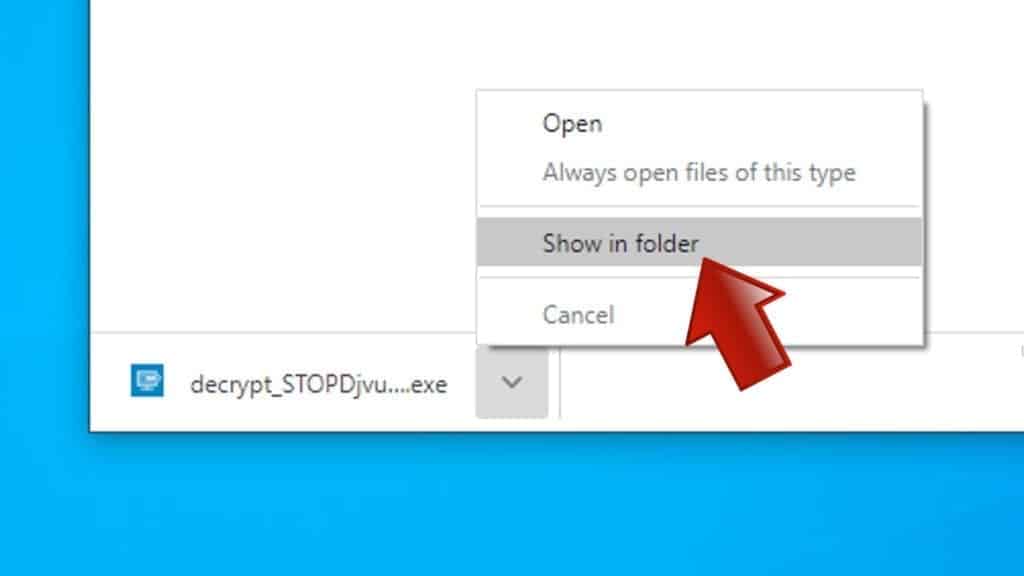
- Now, right-click the file and choose Run as Administrator. If asked, enter administrator's password.
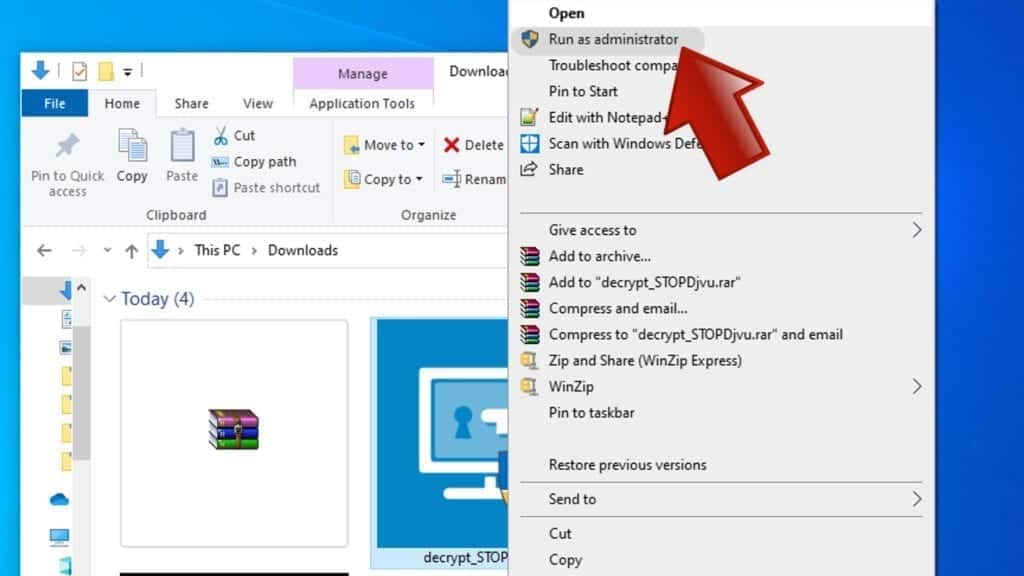
- In UAC window, click Yes.
- Click Yes to agree to software terms in both windows.
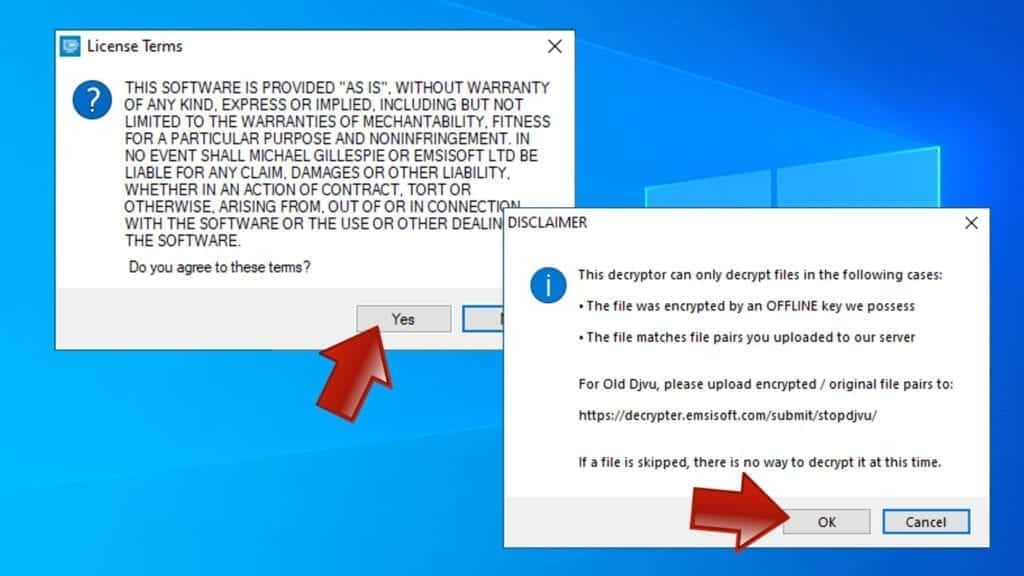
- The tool will automatically include C:// disk as a location to decrypt. The file recovery tool will prepopulate the locations to scan, including connected data storage drives or network drives. Click Add folder if you wish to add additional locations.
In Options tab, you can choose to keep encrypted file copies. We recommend leaving this option selected, especially if you do not know if the decryption tool will work.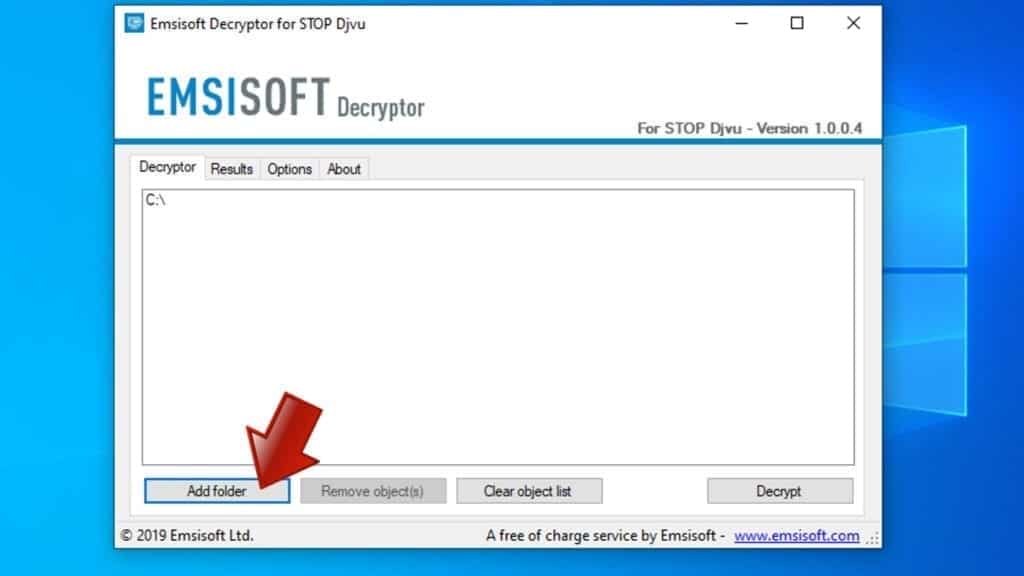
- Click Decrypt to start restoring MADO files. You will see the progress in the Results tab. Here, you can see messages from the tool, such as whether the decryption procedure is successful, or you need to wait for an update.
You might also be informed that online key was used to encrypt your files. In such case, the decryption tool won't work for you, and the only way to recover your files is to use a data backup.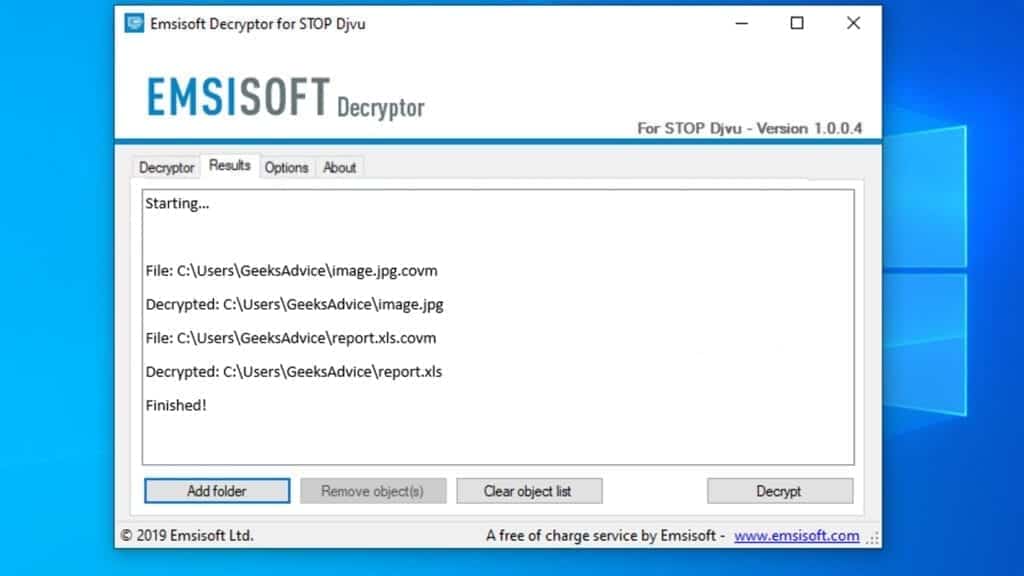
Meanings of decryptor's messages
The MADO decryption tool might display several different messages after failed attempt to restore your files. You might receive one of the following messages:
Error: Unable to decrypt file with ID: [example ID]
This message typically means that there is no corresponding decryption key in the decryptor's database.
No key for New Variant online ID: [example ID]
Notice: this ID appears to be an online ID, decryption is impossible
This message informs that your files were encrypted with online key, meaning no one else has the same encryption/decryption key pair, therefore data recovery without paying the criminals is impossible.
Result: No key for new variant offline ID: [example ID]
This ID appears to be an offline ID. Decryption may be possible in the future.
If you were informed that an offline key was used, but files could not be restored, it means that the offline decryption key isn't available yet. However, receiving this message is extremely good news, meaning that it might be possible to restore your MADO extension files in the future. It can take a few months until the decryption key gets found and uploaded to the decryptor. We recommend you to follow updates regarding the decryptable DJVU versions here. We strongly recommend backing up your encrypted data and waiting.
Report Internet crime to legal departments
Victims of MADO ransomware virus should report the Internet crime incident to the official government fraud and scam website according to their country:
- In the United States, go to the On Guard Online website.
- In Australia, go to the SCAMwatch website.
- In Germany, go to the Bundesamt für Sicherheit in der Informationstechnik website.
- In Ireland, go to the An Garda Síochána website.
- In New Zealand, go to the Consumer Affairs Scams website.
- In the United Kingdom, go to the Action Fraud website.
- In Canada, go to the Canadian Anti-Fraud Centre.
- In India, go to Indian National Cybercrime Reporting Portal.
- In France, go to the Agence nationale de la sécurité des systèmes d’information.
If you can't find an authority corresponding to your location on this list, we recommend using any search engine to look up "[your country name] report cyber crime". This should lead you to the right authority website. We also recommend staying away from third-party crime report services that are often paid. It costs nothing to report Internet crime to official authorities.
Another recommendation is to contact your country's or region’s federal police or communications authority.
Frequently Asked Questions
You can only open MADO files if you have the decryption key, or if you were affected by offline encryption type.
To figure out whether you were affected by offline encryption, please go to C:/SystemID/PersonalID.txt and see if the string inside of it ends in t1. You can also try using Emsisoft Decryptor for STOP/DJVU.
Please follow the guidances provided by the official MADO decryption tools and believe what they say. If they say it is impossible to decrypt, it really is so. There is no magic tool or human capable of decrypting your files hiding somewhere. Encryption is a technique created to be nearly impossible to decrypt without a special private key (held by the criminals).
We advise scanning with anti-virus, anti-malware, malware removal tools or software like RESTORO to eliminate virus damage on the system. If you do not trust using a single tool, try running one after another. However, we do not recommend keeping several security programs on a computer at once as they can interfere with each other's work.
Beware of fake MADO decryption tools circulating around the web. Cyber criminals are uploading them to various shady websites, also might be promoting them via suspicious Youtube videos. These programs can infect your computer even more heavily (Trojans, miners, etc.). We suggest being extremely cautious around the web. If there will be an official STOP/DJVU decryption tool available, it will be widely discussed in public media.

Norbert Webb is the head of Geek’s Advice team. He is the chief editor of the website who controls the quality of content published. The man also loves reading cybersecurity news, testing new software and sharing his insights on them. Norbert says that following his passion for information technology was one of the best decisions he has ever made. “I don’t feel like working while I’m doing something I love.” However, the geek has other interests, such as snowboarding and traveling.
Does anyone know a way to decrypt .MADO files? because the restore point doesn’t work, nor does this decrypt tool.
Hi ..
I fell victim to this virus in one of the crack files for a drawing program. I just wanted to use the program for free, and now all my graphics files, my books, my personal pictures, and other important things have been encrypted in Disk D in the form of Mado ..
I am still searching for a way to restore it or restore at least part of it. I just wanted to know any grudge that humans have for each other in order to cause severe harm to people who do not know them recklessly like this .. I think that there is no benefit from my computer now I want to restore my books and pictures of my family at least ..thanks
You should never download illegal software – please support software developers by buying legitimate copies only. Criminals hunt for people who search for illegal files online, it is a technique used for decades
The file recovery and decryption comes because of the restore point, that leads you to a time point where everything works fine after the infection, so you don’t need to change file extension.
Is there no such way to decrypt the files that has turned to .mado type .??? also uesd decrypt_STOPDjvu but still i amin losing way so plz hlp me out if any way coz i nd some me father (late) pic
So will there be any chance of recovery mado files ever?
I’m a victim too from the virus mado. La3natuLlah 3ala l hacker. If you found a solution to decrypt the files please contact me. Thank you.
Hi,
I am a victim too. Some files can be seen with Linux Ubunt USB…but just a few and mostly mp3
is there any way to remove .mado extension and get back my data
Is there no such way to decrypt the files that has turned to .mado type .???